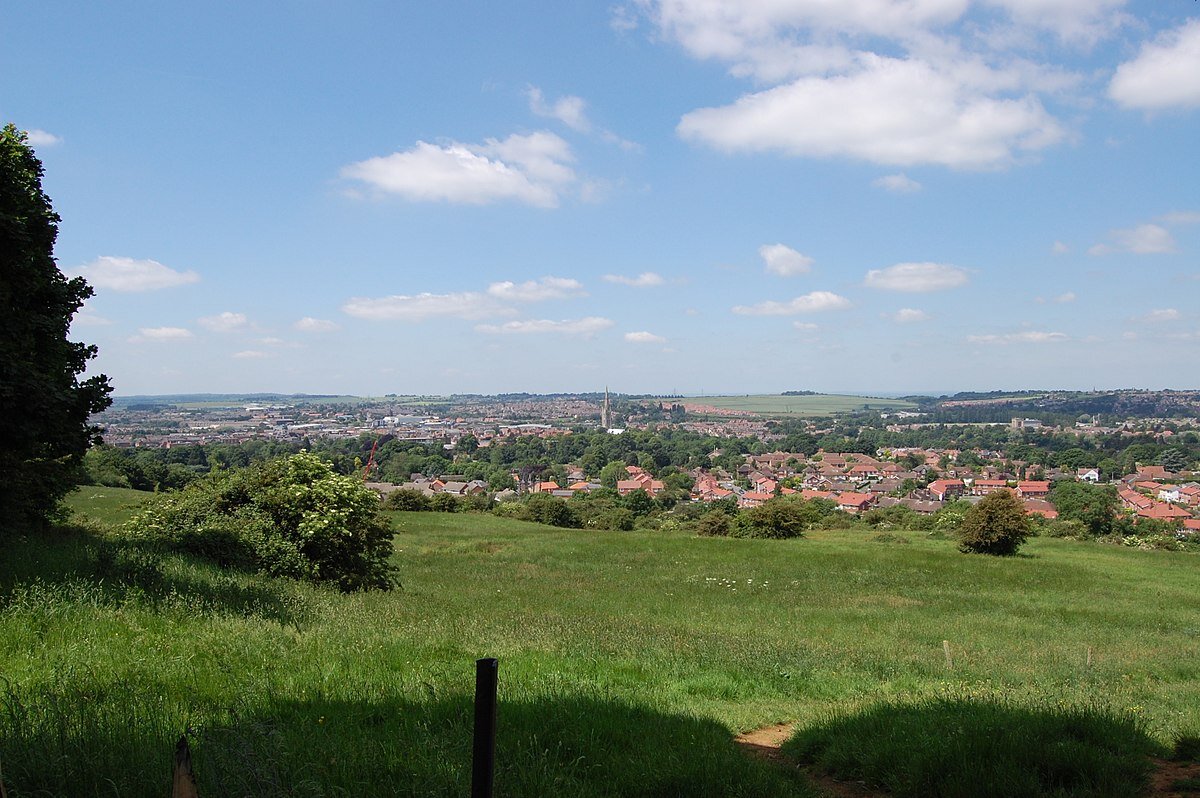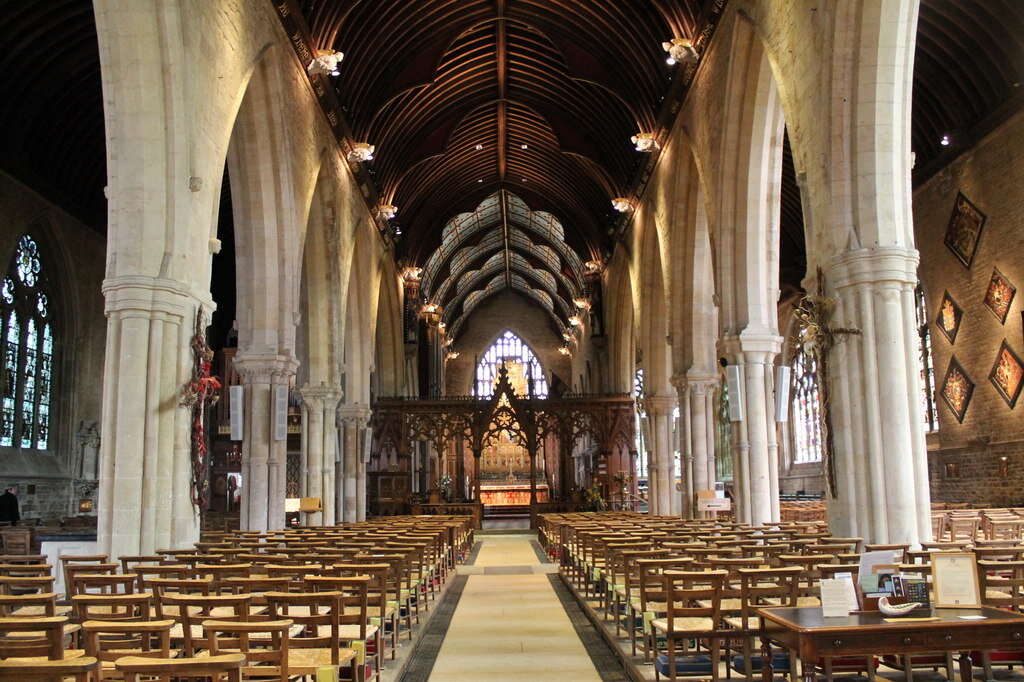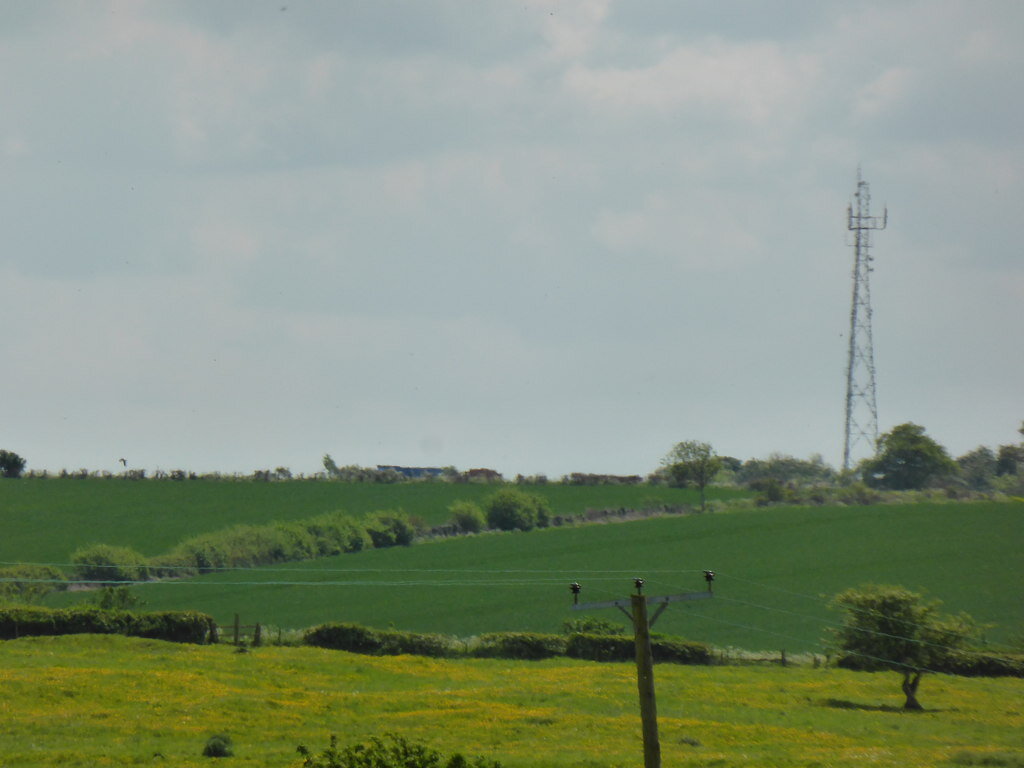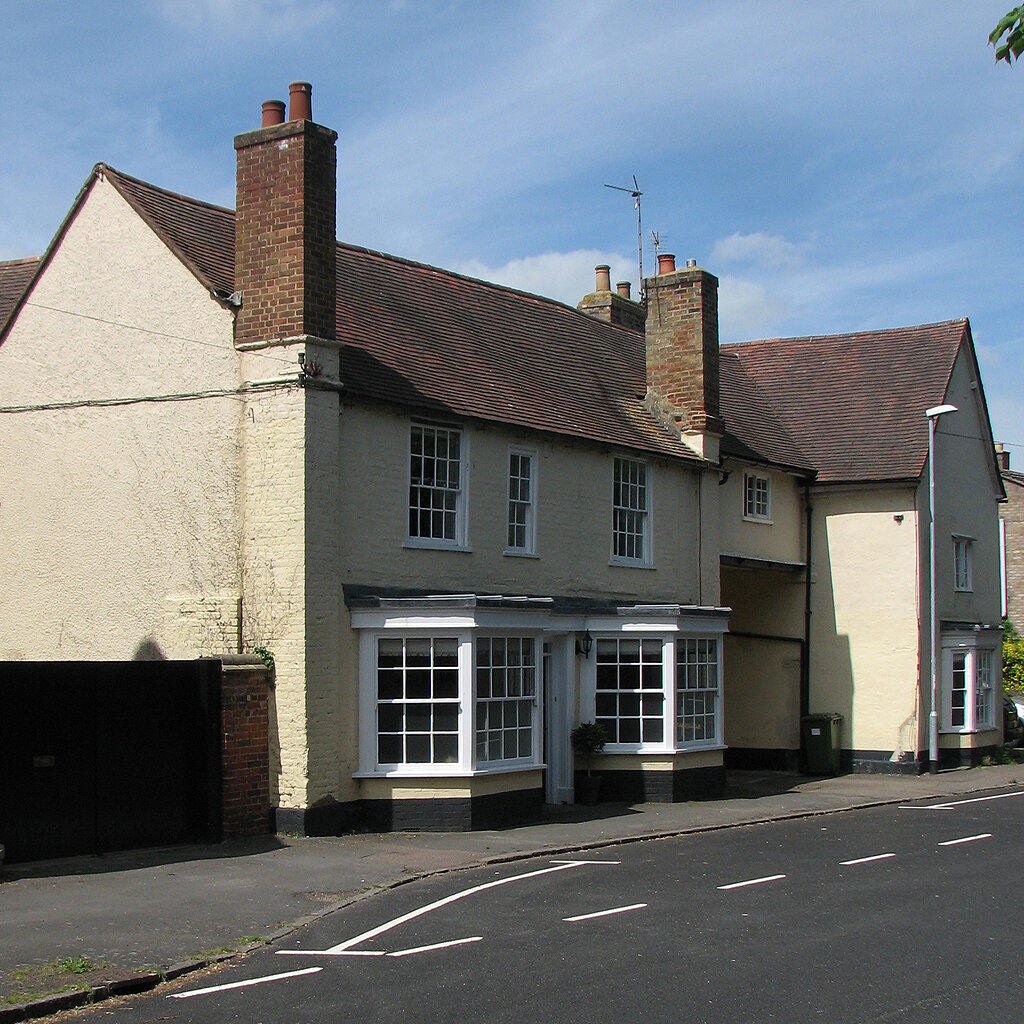Wednesday 3rd November 1819
Wednesday Novb 3rd We went to Grantham 14 miles to Breakfast here is a church well worth seeing thence to Witham Common 10 miles to Stamford 11 miles Stilton 15 miles where we dined it is a small of town Bugden 14 miles and Biggleswade 16 miles here we did intend remaining for the night but the Inn being preoccupied we were obliged to proceed 8 miles further to Baldock a
comfortable Inn. the country over which we passed was very flat but well cultivated the posting very good.
OBSERVATIONS & COMMENTS:
Grantham is bounded to the west by the A1 north–south road. Isaac Newton was educated at its King's School, while Thomas Paine worked there as an excise officer in the 1790s. The main local landmark is the parish church of St Wulfram's, which has the sixth highest spire among English churches at 282.5 feet and is the second tallest church in Lincolnshire.
1833: Grantham. Engraving by J. Rogers after W. Bartlett. Published June, 1833. Later coloured by hand. https://antique-prints-maps.com/acatalog/ref1.php?imagefile=../largeimages/SEGrantham14.jpg
It is also home to England's first public library, dating from 1598, when Francis Trigge, rector of Welbourn, gave £100 for a small chained library of books for the clergy and literate laity of Grantham. Two hundred and fifty of the original volumes remain and are kept in a small room above the South Porch. The Angel and Royal, situated in the High Street, is widely regarded as the oldest surviving English inn.
The Angel and Royal High Street by Jo Turner. Grade I Listed and widely regarded as the oldest surviving English Inn, the main façade of the building that stands today was built approximately 600 years ago. The site then had already been an Inn for 200 years and was built as a hostel for the chivalrous Brotherhood of the Knights Templar. It was then that the building caught the eye of King John who decided it would make a suitable location for a visit of his Royal Court in 1213. An Angel was a common medieval sign that reflected the early connection between religious establishments and a travellers hostel. The Inn was extended in the mid 14th Century and again in the 15th Century. Due to the prime position on the Great North Way (formerly the Ermine Roman Way) the Angel slowly developed to accommodate ever-increasing numbers of wagons and stagecoaches. It was this that most certainly gave the Inn in the last few hundred years its characteristic layout, with its very long courtyard, old stables and entrances to the front and rear. In the Georgian and Victorian period at the Angel they were permitted to remain open as long as they liked until every bed was filled. Up until the middle of the 1800’s the hotel was still classed as an Inn known as The Angel, then following much Royal patronage over the years in 1866 a visit to Grantham by the then Prince of Wales lead to the property getting the second part of its name. It was universally agreed that the visit should be commemorated by the incorporation of “Royal” in the Inn’s name; thus The Angel & Royal came into being but it was not until the early 1920’s that the word Inn was dropped and the building became a hotel. The hotel had a number owners between the second world war and 2002 when it was purchased by a local consortia of business professionals whose intention it was to bring this historic and much loved property back to its former glory. It is now (2013) owned by Ashdale Hotels and a member of the BEST WESTERN brand. © Copyright Jo Turner and licensed for reuse under the (CC BY-SA 2.0) Creative Commons Licence. https://www.geograph.org.uk/photo/3629492
The façade of the main building as it appears today was built about 600 years ago, but the site had already been an inn for 200 years. It was originally built as a hostel for the Knights Templar. King John is reputed to have visited with his Royal Court in 1213. The inn was extended in the mid-14th century and again in the 15th century. visit by Richard III was the origin of the gold emblem angel holding the King's crown over the original archway. In 1483 Richard held court and it was from the "Chambre de' Roi", that he dispatched a letter bidding for the Great Seal to proclaim the treachery of his cousin, the Duke of Buckingham, leading to the signature of Buckingham's death warrant. King Charles I made use of the King's Room during his visit in 1633 and Oliver Cromwell also stayed at the Angel after his successful battle near Grantham in 1643. The cellars and foundations of the inn are reputed to date from the 9th century, and are rumoured to be linked by tunnels to both St Wulfram's Church and the town's Market Square. In 1707 the then landlord Michael Solomon died, but left a legacy of 40 shillings a year to pay for the preaching of a sermon, against the evils of drunkenness, for every Mayor. The prime position of the inn on the Great North Road led to its long history as a coaching inn, which accounts for its characteristic layout, with long courtyard, old stables and entrances to front and rear. In 1800 six inns were listed in Grantham, together with 21 alehouses, and it remained popular with the patronage of King George IV, 1762-1830. https://en.wikipedia.org/wiki/Grantham
2008: Grantham town centre as seen from the top of the hills and hollows with St. Wulfram's Church as the focal point by David Johnson, the copyright holder of this work, and published under the Creative Commons Attribution-Share Alike 4.0 International, 3.0 Unported, 2.5 Generic, 2.0 Generic and 1.0 Generic license. https://commons.wikimedia.org/wiki/File:Grantham_Town.jpg
St Wulfram's Church, Grantham was complimented by Simon Jenkins in his “England's Thousand Best Churches” with: "Here is the finest steeple in England", which was probably influenced by Salisbury Cathedral.
1797: Grantham Church by J M W Turner, Engraver & Publisher Batholomew Howlett. http://www.rareoldprints.com/p/20437
St Wulfram, Grantham by John Salmon. © Copyright John Salmon and licensed for reuse under the (CC BY-SA 2.0) Creative Commons Licence. https://www.geograph.org.uk/photo/5659039
Of interest are window frames from different periods, the use of ballflower ornament and the crypt chapel. The present organ by John Harris and John Byfield dates from 1735. It was rebuilt by George Pike England in 1809 and 1833. The north porch was built to house relics of St Wulfram (possibly an arm bone), and the chained library occupies a room over the south porch which was once a priests' living room. The books were most probably obtained from Cambridge. More than 80 volumes are kept secured by chains. The earliest book, printed in Naples in 1476, is found in no other library. There are 356 separate items and the collection has recently been examined, repaired and catalogued. The library is housed above the south porch, where a squint window allows viewers in the library to see all parts of the church, but to remain almost invisible from the body of the church. The crypt chapel was probably dedicated to the Holy Trinity and was originally entered from outside. A staircase was built in the 15th century allowing access from the church interior. The crypt door and chests are the only remaining examples of medieval woodwork in the church. The crypt has been used as a depository for the relic of St Wulfram, as a charnel house when the graveyard became full, and a store-room for church valuables and corporation records. In 1808 the church silver was stolen from the crypt and never recovered. So many pilgrims have visited the crypt that the stone steps have worn down and been inverted. The stone in front of the altar has also been worn away by the knees of pilgrims. https://en.wikipedia.org/wiki/St_Wulfram%27s_Church,_Grantham
Interior, St Wulfram's church, Grantham by J.Hannan-Briggs. The parish church of St Wulfram is one of the largest medieval churches in the country, seating around 700 people. Constructed in the early 1300s, at 282 ft. the spire is one of the highest in the country on a parish church, dominating the views of the town. The church is built of Lincolnshire limestone, probably from around the Ancaster area. The spacious interior has fine vistas across the broad nave and aisles. Inside and outside is a whole gallery of carved stone heads, most of them medieval, some no doubt portraits of local people of the time, some grotesques, some animals. The chancel is dominated by the Victorian reredos, incorporating Italian paintings. It was designed by Sir Arthur Blomfield and extended by Sir Walter Tapper (who also designed the organ case and font cover) © Copyright J.Hannan-Briggs and licensed for reuse under the (CC BY-SA 2.0) Creative Commons Licence. https://www.geograph.org.uk/photo/3216261 (more information on the interior at this link)
Witham Common: The Old Black Bull, formerly listed as Bull Farmhouse, was a former coaching inn, now house. c.1731 with late C18 alterations and c.1800 extension. https://britishlistedbuildings.co.uk/101168232-the-old-black-bull-north-witham#.XD4XAVz7Q5s . In a map of Witham Common dated 1887 it is shown as “Black Bull” https://www.francisfrith.com/witham-common/maps
The mast by the Black Bull by Bob Harvey. A long-closed coaching inn on the A1 is remembered by the name of Black Bull Lane, and this mast (seen here from Old Post Lane) is at Black Bull © Copyright Bob Harvey and licensed for reuse under the (CC BY-SA 2.0) Creative Commons Licence. https://www.geograph.org.uk/photo/5405855
Stamford lies on the main north-south route (Ermine Street, the Great North Road and now the A1) from London to York and Edinburgh.
1833: Stamford. Engraving by W. Watkins. Published by John Saunders in 1833. Later coloured by hand. https://antique-prints-maps.com/acatalog/ref1.php?imagefile=../largeimages/SEStamford14.jpg
The George, the Bull and Swan, the Crown and the London Inn were well-known coaching inns. (The George is shown, below:)
2006: The George Hotel. The famous George at Stamford, one of England's greatest coaching Inns http://www.georgehotelofstamford.com/. The Great North Road used to pass through Stamford. This image was taken from the Geograph project collection. The copyright on this image is owned by Richard Croft and is licensed for reuse under the (CC BY-SA 2.0 ) Creative Commons Attribution-ShareAlike 2.0 license. https://commons.wikimedia.org/wiki/File:The_George_Hotel_-_geograph.org.uk_-_160244.jpg
Stamford has been hosting an annual fair since the Middle Ages. Stamford fair is mentioned in Shakespeare's Henry IV, Part 2 (Act 3, Scene 2). The mid-Lent fair is the largest street fair in Lincolnshire and one of the largest in the country.
Shopping in Stamford by Anthony O'Neil. © Copyright Anthony O'Neil and licensed for reuse under the (CC BY-SA 2.0 ) Creative Commons Licence. https://www.geograph.org.uk/photo/4837933
On 7 March 1190, crusaders at the fair led a pogrom; many Jews in the town were massacred. For over 600 years Stamford was the site of the Stamford Bull Run festival, held annually on 13 November, St Brice's day, until 1839. According to local tradition, the custom was started by William de Warenne, 5th Earl of Surrey, after he saw two bulls fighting in the meadow beneath his castle viewpoint. Some butchers came to part the combatants and one of the bulls ran into the town. The earl mounted his horse and rode after the animal; he enjoyed the sport so much that he gave the meadow in which the fight began to the butchers of Stamford on condition that they should provide a bull, to be run in the town every 13 November, for ever after. https://en.wikipedia.org/wiki/Stamford,_Lincolnshire
Stilton: It's reliance on its position on the Great North Road has twice led to problems when use of the road reduced, first with the arrival of the railway and later with the 1958 bypass, the first from London to Newcastle when the A1 was completely improved in the late 1950s and early 1960s. As a result the Bell Inn closed and fell into disrepair and the village as a whole lost many businesses. To try to revive interest, on Easter Monday 1962 Tom McDonald of The Talbot and Malcolm Moyer of the Bell Inn organised the first cheese-rolling race along a course near the post office. Held every May Day holiday, it became a popular annual event.
2005: The Bell at Stilton by Toby Speight. One of the many great coaching inns that lined the Great North Road. No longer a traveller's stopping place, as Stilton is now bypassed by the A1 motorway, leaving it a peaceful, sleepy village once again. This image was taken from the Geograph project collection. The copyright on this image is owned by Toby Speight and is licensed for reuse under the (CC BY-SA 2.0 ) Creative Commons Attribution-ShareAlike 2.0 license. https://commons.wikimedia.org/wiki/File:The_Bell_at_Stilton_-_geograph.org.uk_-_58448.jpg
The first known written reference to Stilton cheese appeared in William Stukeley's Itinerarium Curiosum, Letter V, dated October 1722. Daniel Defoe in his 1724 work: “A tour thro' the whole island of Great Britain” notes, "We pass'd Stilton, a town famous for cheese, which is call'd our English Parmesan, and is brought to table with the mites, or maggots round it, so thick, that they bring a spoon with them for you to eat the mites with, as you do the cheese." Traditionally it was thought that supplies were obtained from the housekeeper at Quenby Hall, Hungarton, and were sold via her brother-in-law to travellers in Stilton's coaching inns, namely the Bell Inn or the Angel Inn.
1745: Mr Cowper Thornhill Master of the Bell Inn at Stilton in Huntingdon-Shire. Publisher: Robert Wilkinson. Cowper or Cooper Thornhill is credited as the inventor of Stilton cheese and was certainly its first promoter, selling the cheeses from the Bell Inn. http://www.rareoldprints.com/p/10258
Subsequent research has led to claims that the cheese did originate in the village in the late 17th or early 18th centuries, before any contemporary references to its production in Leicestershire. https://en.wikipedia.org/wiki/Stilton
Buckden: It's location on the Great North Road meant that it was used as a coaching stop during the 18th century. There were four coaching inns in the village. The Lion dates back to the 15th century and was extended in the 18th century.
The Lion Hotel, Buckden, Cambridgeshire by Robert Edwards.The Lion Hotel, or as it has been known, 'The Lion and the Lamb' or 'Lamb and Flag' was built in 1492 and is believed to have been a guest house for the Bishop of Lincoln's Palace. © Copyright Robert Edwards and licensed for reuse under the (CC BY-SA 2.0 ) Creative Commons Licence. https://www.geograph.org.uk/photo/108061
The George Inn which had its own courtyard and forge was remodelled in the 18th century.
Buckden: High Street and The George by John Sutton. To the left is the former coaching inn, The George. The High Street was once part of The Great North Road, which now bypasses the village. The George is Grade II listed © Copyright John Sutton and licensed for reuse under the (CC BY-SA 2.0 ) Creative Commons Licence. https://www.geograph.org.uk/photo/3913740
The Vine dated back to the first half of the 17th century and was rebuilt in the 18th century when it included stables and its own brewery.
The Vine - Buckden by Mick Lobb. © Copyright Mick Lobb and licensed for reuse under the (CC BY-SA 2.0 ) Creative Commons Licence. https://www.geograph.org.uk/photo/1891191
The Spread Eagle originally built in the 17th century was altered in the 18th century; it had stabling and paddocks.
Buckden: the former Spread Eagle Inn by John Sutton. An eighteenth-century coaching inn on Buckden High Street, originally The Great North Road. © Copyright John Sutton and licensed for reuse under the (CC BY-SA 2.0 ) Creative Commons Licence. https://www.geograph.org.uk/photo/4495322
A schedule from 1839 showed that there were six express coaches heading north daily to Boston, Leeds, Lincoln, and York and as many heading south to London. The presence of elegant Georgian houses on Church Street and the High Street (formerly the Great North Road) reflects the prosperity that was brought to Buckden by its strategic position on the coaching route north from London. https://en.wikipedia.org/wiki/Buckden,_Cambridgeshire
Biggleswade is mentioned twice in the diaries of Samuel Pepys. On 22 July 1661, Pepys stopped off at "Bigglesworth" to buy a pair of warm woollen stockings. On 5 August 1664, Pepys's wife, on a visit to relations in Huntingdonshire, sent him a message saying she had arrived in "Bigglesworth" on the coach from York and would be home next day. The diarist John Byng, 5th Viscount Torrington (1743-1813) often refers to the town and its Sun Inn. On 16 June 1785 there was a large fire in the town that started at the Crown Inn and spread rapidly through the neighbouring streets, leaving nearly one-third of the town destroyed, including 103 houses with 332 people homeless. Biggleswade once had numerous inns and public houses due to its location on the Great North Road. All of 52 were trading in 1876. By July 2019, just nine remained, plus an additional new-build.
Biggleswade: Crown Hotel by Chris Downer. An inn right in the centre of town, in whose yard the great fire of Biggleswade started in 1785. © Copyright Chris Downer and licensed for reuse under the (CC BY-SA 2.0 ) Creative Commons Licence. https://www.geograph.org.uk/photo/884567
Of historical importance are The Crown Hotel, rebuilt in 1793 after the Great Fire of 1785, was reopened by J D Wetherspoon in August 2017 after standing empty for four years and the 17th-century, Grade II listed White Hart, which is thought to be the town's second oldest building after St Andrew's Church. https://en.wikipedia.org/wiki/Biggleswade
Victoria Place, Biggleswade, Beds by Rodney Burton. View of the centre of Biggleswade with memorial, civic building and White Hart pub. © Copyright Rodney Burton and licensed for reuse under the (CC BY-SA 2.0 ) Creative Commons Licence. https://www.geograph.org.uk/photo/53051
Baldock thrived where the old Great North Road and the Icknield Way crossed.
1787: A View of Baldock in Hertfordshire , “The Man of the Mill had a Daughter so fair With so pleasing a and so winning an air That once on the Hayfields' green Bank as I stood I thought she was Venus just sprung from the Flood.” Artist Robert Pollard, Engraver Francis Jukes, Drawn October 20th 1786. http://www.rareoldprints.com/z/3311
Thanks to its location, the town was a major staging post between London and the north: many old coaching inns still operate as pubs and hotels, and Baldock has a surprising number of pubs for its size. It's position has made it a stopping point for a number of illustrious visitors, including Charles I, who passed through Baldock en route for London after his arrest in 1648, and supposedly Dick Turpin. Preacher John Wesley came to the town in 1747. From the 1770s until 2008 the high street was very wide, a typical feature of medieval market places where more than one row of buildings used to stand. In the case of Baldock, the bottom of the High Street had three such rows, until Butcher's Row was demolished by the Turnpike authorities in the 1770s.
Baldock High Street by Robin Hall. Taken at 4:30 p.m. the traffic is beginning to build. By 6 p.m. this will be a nightmare. This is a lovely old town with an old coaching inn where you can bang your head on the ceiling. © Copyright Robin Hall and licensed for reuse under the (CC BY-SA 2.0 ) Creative Commons Licence. https://www.geograph.org.uk/photo/30975
The Wynn alms houses, in the High Street, were founded in 1621 and were endowed "To the World's End" by John Wynne, a cloth merchant from London who left £1000 in his will of 1614 for their upkeep. https://en.wikipedia.org/wiki/Baldock
Inn: The George coaching inn dates back to the 15th century. http://www.thegeorgeatbaldock.co.uk/#the-george
Baldock: the corner of High Street by John Sutton. The centre of the town, where High Street, Hitchin Street, Church Street and Whitehorse Street meet. The George (once The George and Dragon) is Grade II listed. The parish church tower is topped with a Hertfordshire spike of a rather grander sort than those found in nearby villages. © Copyright John Sutton and licensed for reuse under the (CC BY-SA 2.0 ) Creative Commons Licence. https://www.geograph.org.uk/photo/4822745
Up to the 1880’s the Old White Horse on Whitehorse Street was a meeting place for Victorian artistic and literary people such as the painter Millais and the cartoonist Leech. The Rose and Crown public house can be seen in the foreground of the postcard of White Horse Street which was a noted stopping place for the Baldock Cycling Touring Club. http://www.hertsmemories.org.uk/content/herts-history/towns-and-villages/baldock/baldock
Can you help us?
Old Regency Prints, Pictures an Coaching maps: Do you have access to any prints or pictures showing what town and country would have looked like when Lucy travelled through? Any illustrations of what she would have seen in 1819 will enliven our research.
New Pictures: Do you have any modern pictures of the streets, buildings, gardens and views that would enable us to see the changes that two centuries have wrought?






















